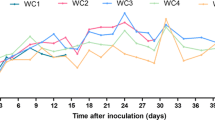Abstract
Non-human primates have been playing an essential role in the study of hepatitis A virus (HAV) biology, pathogenesis and for testing candidate HAV vaccines. This study was to determine the suitability of squirrel monkeys (Saimiri sciureus) as animal model for HAV infection. Animals were inoculated, either intragastrically or intravenously, with a Brazilian HAV isolate (HAF-203). Alanine aminotransferase (ALT) and anti-HAV antibodies (IgM and total) were monitored. Feces were daily collected for HAV antigen and HAV RNA detection. Samples of liver tissue were obtained by biopsy before inoculation at peak ALT levels and/or when anti-HAV antibodies developed, and at necropsy for morphological examination. Monkeys inoculated by the intravenous route rapidly developed significant elevations of serum ALT, anti-HAV antibodies, and liver histologic changes, while the only evidence of HAV infection in intragastrically inoculated animals was the seroconversion. Moreover, squirrel monkeys excreted very low levels of HAV detectable in only few fecal samples after amplification by RT-PCR, different from humans and other non-human primate species that eliminate large quantities of virus during the late incubation period. The unusual onset of hepatitis A in experimentally infected squirrel monkeys represent an important obstacle for its use as animal model for the study of this viral infection. However, they can represent a valuable tool for the obtention of hyperimmune sera for HAV, in the view of the very high titer of anti-HAV developed (105) 24 days after a single intravenous inoculation.
Similar content being viewed by others
References
Asher, L. V. S.;Binn, L. N.;Mensing, T. L.;Marchwicki, R. H.;Vassel, R. A.;Young, G. D. 1995. Pathogenesis of hepatitis A in orally inoculated owl monkeys (Aotus trivirgatus).J. Med. Virol., 47: 260–268.
Boom, R.;Sol, C. J. A.;Salimans, M. M. M.;Jansen, C. L.;Wertheim-van-Dillen, P. M. E.;Vand der Noordaa, J. 1990. Rapid and simple method for purification of nucleic acids.J. Clin. Microbiol., 28: 495–503.
Crowell, R. L.;Tomko, R. P. 1994. Receptors for picornaviruses. In:Cellular Receptors for Animal Viruses,Wimmer,E. (ed.), Cold Spring Harbor Labor. Press, New York, pp. 75–99.
D’Hondt, E.;Purcel, R. H.;Emerson, S. U.;Wong, D. C.;Shapiro, M.;Govindarajan, S. 1995. Efficacy of an inactivated hepatitis A vaccine in pre- and post-exposure conditions in marmosets.J. Infect. Dis., 171 (suppl. 1): S40-S43.
Dienstag, J. L.;Feinstone, S. M.;Kapikian, A. Z.;Purcell, R. H. 1975. Fecal shedding of hepatitis A antigen.Lancet, 1: 765–767.
Gaspar, A. M. C.;Vitral, C. L.;Marchevsky, R. S.;Yoshida, C. F. T.;Schatzmayr, H. G. 1992a. A Brazilian hepatitis A virus isolated and adapted in primate and primate cell line as a chance for the development of a vaccine.Mem. Inst. Oswaldo Cruz, 87: 449–450.
Gaspar, A. M. C.;Vitral, C. L.;Yoshida, C. F. T.;Schatzmayr, H. G. 1992b. Primary isolation of a Brazilian strain (HAF-203) of hepatitis A virus in primate cell line (FRhK-4).Braz. J. Med. Biol. Res., 25: 697–705.
Gaspar, A. M. C.;Vitral, C. L.;Yoshida, C. F. T.;Schatzmayr, H. G. 1993. Fast and high titre growth of a Brazilian hepatitis A virus (HAF-203) in primate cell line.Braz. J. Med. Biol. Res., 26: 203–206.
Krawczynski, K. K.;Bradley, D. W.;Murphy, B. L.;Ebert, J. W.;Anderson, T. E.;Doto, I. L.;Nowoslawski, A.;Duermeyer, W.;Maynard, J. E. 1981. Pathogenetic aspects of hepatitis A virus infection in enterally inoculated marmosets.Amer. J. Clin. Pathol., 76: 698–706.
Perraut, R.;Gerraud, O. 1998. Vaccination trials and immune response againstPlasmodium falciparum in Saimiri monkeys.Med. Trop., 58: 76–84.
Pinto, M. A.; Marchevsky, R. S.; Pelajo-Machado, M.; Santiago, M. A.; Pissurno, J. W.; França, M. S.; Baptista, M. L.; Gouvea, A.; Santana, A.; Bertho, A. L.; Schatzmayr, H. G.; Gaspar, A. M. C.; Kubelka, C. F., 2000. Inducible nitric oxide synthase (iNOS) expression in liver and splenic T lymphocyte rise are associated with liver histological damage during experimental hepatitis A virus (HAV) infection inCallithrix jacchus. Exp. Toxicol. Pathol., 52.
Prevot, S.;Marechal, J.;Pillot, J.;Prevot, J. 1992. Relapsing hepatitis A in Saimiri monkeys experimentally reinfected with a wild type hepatitis A virus (HAV).Arch. Virol. (suppl. 4): 5–10.
Purcell, R. H.;D’Hondt, E.;Bradbury, B.;Emerson, S. U.;Govindarajan S.;Binn, L. 1992. Inactivated hepatitis A vaccine: active and passive immunoprophylaxis in chimpanzees.Vaccine, 10: 148–151.
Vitral, C. L.;Gaspar, A. M. C.;Yoshida, C. F. T. 1991. Two competitive enzyme immunoassays for the detection of IgG class antibodies to hepatitis A antigen.Rev. Soc. Bras. Med. Trop., 24: 79–85.
Vitral, C. L.;Marchevsky, R. S.;Yoshida, C. F. T.;Coelho, J. M. C. O.;Gaspar, A. M. C.;Schatzmayr, H. G. 1995. Intragastric infection induced in marmosets (Callithrix jacchus) by a Brazilian hepatitis A virus (HAF-203).Braz. J. Med. Biol. Res., 28: 313–321.
Vitral, C. L.;Yoshida, C. F. T.;Gaspar, A. M. C. 1998. The use of non-human primates as animal models for the study of hepatitis viruses.Braz. J. Med. Biol. Res., 31: 1035–1048.
Author information
Authors and Affiliations
About this article
Cite this article
Vitral, C.L., Yoshida, C.F.T., Marchevsky, R.S. et al. Studies on transmission of hepatitis A virus to squirrel monkeys. Primates 41, 127–135 (2000). https://doi.org/10.1007/BF02557794
Received:
Accepted:
Issue Date:
DOI: https://doi.org/10.1007/BF02557794




